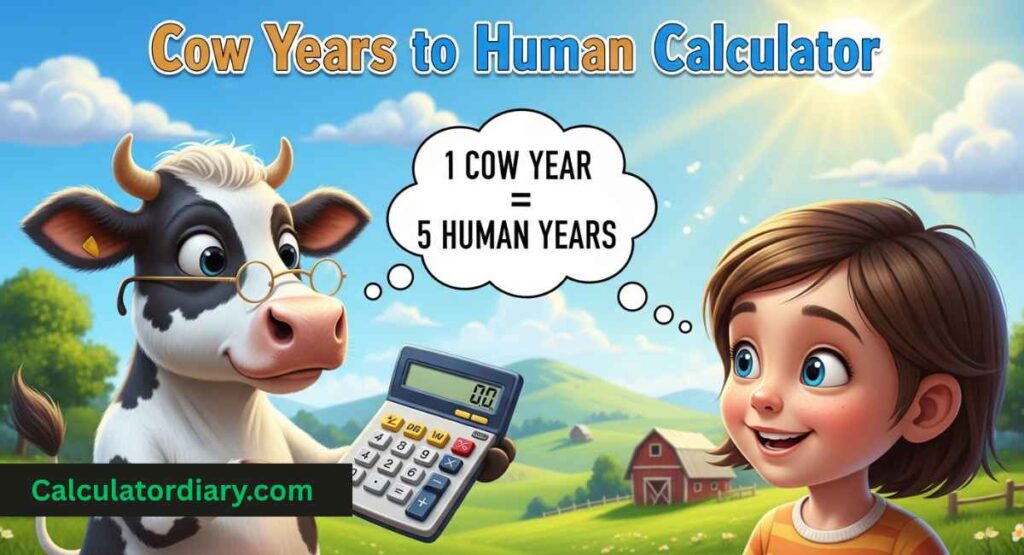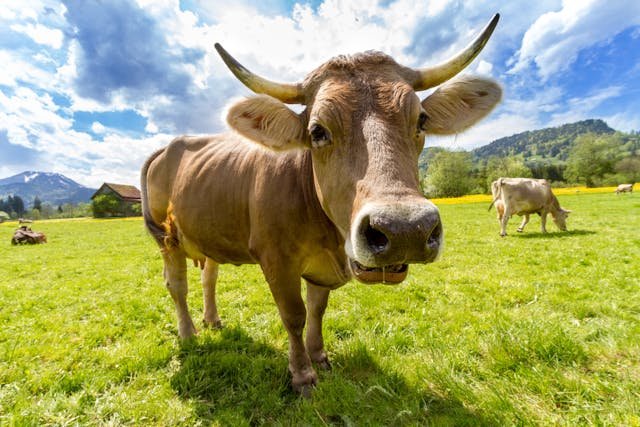Cows have always been an integral part of human society, from farm animals to symbols of cultural significance around the world. But have you ever wondered how a cow’s age compares to that of a human? Just like with pets and other animals, understanding how to convert cow years to human years allows us to better appreciate their life stages, behavior, and care needs.
Cows experience a vastly different lifespan and aging process when compared to humans. While their physical maturity happens relatively quickly, their later years see a slower rate of aging. By decoding these differences, you’ll gain insights into how cows grow, mature, and age throughout their lives.
Dive in to learn how to calculate a cow’s age in human terms, discover fascinating facts about their lifecycles, and explore their unique aging process.

What is a Cow?
A cow is a domesticated mammal belonging to the species Bos taurus. Cows are well-known for their importance in agriculture, primarily as sources of milk, meat, and labor. They are social animals, forming tight-knit herds, and they display remarkable intelligence with the ability to form bonds and recognize individuals over time.
With lifespans reaching up to 20 years when cared for well, cows can live rich and fulfilling lives. Their life stages—from calves to mature adults and seniors—mirror those of most mammals, albeit at a faster pace.
How Cows Age Compared to Humans
Cows age faster than humans during their first few years. For example, a 2-year-old heifer can be compared to a teenager in human years, as they reach physical and reproductive maturity fairly quickly. However, as they age, their development slows, and the aging curve flatten out, making them more stable throughout their adult lives.
Understanding how cows age differently from humans helps farmers and caretakers make informed decisions about their care at all life stages, from nutrition to health practices.

Understanding the Cow-to-Human Age Conversion Formula
To estimate a cow’s age in human years, we use the following widely accepted formula:
- The first cow year equals approximately 14 human years.
- The second cow year adds an additional 8 human years.
- Every subsequent cow year equates to about 4 human years.
This formula is based on the rapid initial maturity of cows, followed by a more gradual rate of aging in their adult years.
Cow Years to Human Years Chart
Here’s a simple chart to visualize the relationship between cow years and human years:
| Cow’s Age (Years) | Human Age Equivalent |
|---|---|
| 1 | 14 |
| 2 | 22 |
| 3 | 26 |
| 4 | 30 |
| 5 | 34 |
| 6 | 38 |
| 7 | 42 |
| 10 | 54 |
| 15 | 74 |
| 20 | 94 |
By understanding this chart, it becomes clear how quickly cows age in their earlier years and how their aging slows significantly as they mature.
For example, a 5-year-old cow is equivalent to about 34 human years, whereas a 10-year-old cow would be about the equivalent of 54 in human years.

How to Determine Your Cow’s Age in Human Years
To determine your cow’s age in human years, you can follow these steps:
- Account for the first year:
The first year of a cow’s life is roughly equivalent to 14 human years, as this is the most developmental stage in their lifespan. - Add the second year:
During their second year, cows mature further, which adds about 8 additional human years, making a 2-year-old cow roughly 22 in human years. - Add 4 human years for each subsequent year:
For every year after the second birthday, simply add approximately 4 human years to estimate their age.
For example, a 6-year-old cow would be calculated as follows:
- First year = 14 human years
- Second year = 8 human years
- Each subsequent 4 years (4 x 4 years) = 16 human years
= 38 human years
Life Stages of Cows
- Calf (0–1 year): Comparable to a human infant. Cows at this stage are highly dependent on their mothers for survival.
- Juvenile (1–2 years): Similar to human teenagers, juvenile cows grow rapidly during this phase and may begin to exhibit independent behaviors.
- Adult Cow (2–8 years): This is the most productive phase of their lives, equivalent to humans between their 20s and 40s, during which cows are healthy and active.
- Mature Cow (8+ years): Aging cows slow down, much like humans in their 50s and beyond. They may require additional care tailored to senior needs.
These stages help identify a cow’s physical and behavioral developments over time, making it easier to meet their specific healthcare and feeding requirements.
How Many Cow Years Are in a Human Year?
Depending on their life stage, one cow year averages between 4 and 14 human years. The first few years of life have the highest equivalency due to their rapid growth, but as cows age, their human-equivalent aging slows significantly.
This dynamic aging process ensures that each stage of their life demands different care practices and attention.
Cow Age Chart
Here’s a detailed cow age chart for quick reference:
| Cow’s Age | Human Equivalent Age |
|---|---|
| 6 months | 7 years |
| 1 year | 14 years |
| 2 years | 22 years |
| 3 years | 26 years |
| 5 years | 34 years |
| 10 years | 54 years |
| 15 years | 74 years |
| 20 years | 94 years |
This chart provides a practical way to appreciate how cows’ age translates into human years at all stages of their life.
How Cows Age Over Time
Cows, like all animals, go through distinct phases of aging. Here is what these phases look like:
- Calf Phase (0–1 year):
During the calf stage, rapid growth occurs. They start actively exploring their surroundings and learn social behaviors within the herd. - Juvenile Phase (1–2 years):
Young cows typically enter adolescence around this time, reaching puberty and transitioning into young adulthood. - Adult Phase (2–8 years):
Adult cows are fully developed and can reproduce. Dairy cows are most productive during this timeframe, and they thrive on a consistent diet and healthcare routine. - Senior Phase (8+ years):
Mature cows require more support, especially in terms of joint health and overall mobility. They may gradually slow down like elderly humans.
Identifying these phases ensures appropriate care for each stage and helps farmers and caretakers plan feeding, health checks, and workload management effectively.
Why is It Important to Know a Cow’s Age in Human Years?
Understanding a cow’s age in human terms offers numerous benefits, from improving their care to building stronger bonds.
- Dietary Adjustments: Senior cows may benefit from softer, more nutrient-rich food, while younger cows require energy-dense diets for growth.
- Health Monitoring: Knowing their age ensures timely interventions for age-related health concerns, like arthritis or weight management.
- Efficiency in Farming: Farmers can better plan breeding schedules, milking cycles, and workload management for adult cows in their prime.
Understanding their life stages also deepens our respect for cows as living beings with specific needs during every phase of life.
What is the Average Cow’s Life Expectancy?
The lifespan of a cow largely depends on its environment and purpose:
- Wild or pasture cows: Typically live 15–20 years in favorable conditions.
- Dairy cows: Often live 5–7 years, as their bodies are subject to the physical toll of frequent milk production.
- Pet or sanctuary cows: With minimal stress and excellent care, some cows live well into their 20s or occasionally beyond.
Providing a safe environment, nutritious food, and regular veterinary care can significantly extend a cow’s lifespan.
Common Myths About Cow Aging
Myth 1: “Cows age like humans.”
While cows have comparable life stages, especially in their youth, their overall lifespan is much shorter, typically 15–20 years at most.
Myth 2: “All cows live the same length of time.”
Life expectancy varies depending on the cow’s breed, purpose (dairy vs. meat vs. companion), and living conditions.
Myth 3: “A 10-year-old cow is old.”
Not necessarily! A healthy 10-year-old cow is still in its middle years and can contribute to the herd or farm with proper care.
Debunking these myths helps put their aging process into perspective and encourages better treatment for cows of all ages.
Key Takeaways
- The first year of a cow’s life equals 14 human years, while subsequent years age at approximately 4 human years each.
- Understanding cow years in human terms helps provide age-appropriate care and better anticipate health and behavioral changes.
- Cows live an average of 15–20 years, with significant variation depending on living conditions and purpose.
Whether you’re caring for a farm animal or simply intrigued by their life cycle, appreciating a cow’s aging process is one step toward valuing these incredible animals and ensuring their welfare through every stage of life.
FAQs
Q: How old is a 5-year-old cow in human years?
A 5-year-old cow is equivalent to about 34 human years.
Q: How long do cows live in the wild?
Cows in the wild typically live 15–20 years when not exposed to significant threats.
Q: Is a cow old at 10 years?
No, a 10-year-old cow is at the equivalent of 54 human years and is still capable of living several more active years with proper care.
Q: How do you calculate a cow’s age in human years?
Use the formula of 14 human years for the first year, 8 for the second, and 4 for each additional year.
Q: Can a cow live up to 30 years?
Yes, in optimal conditions like sanctuaries, some cows can live up to 30 years or more.
Cows are truly remarkable animals that deserve recognition, care, and respect no matter their age.
